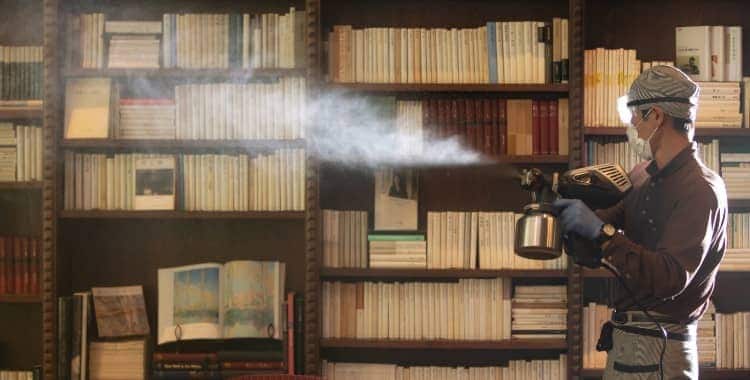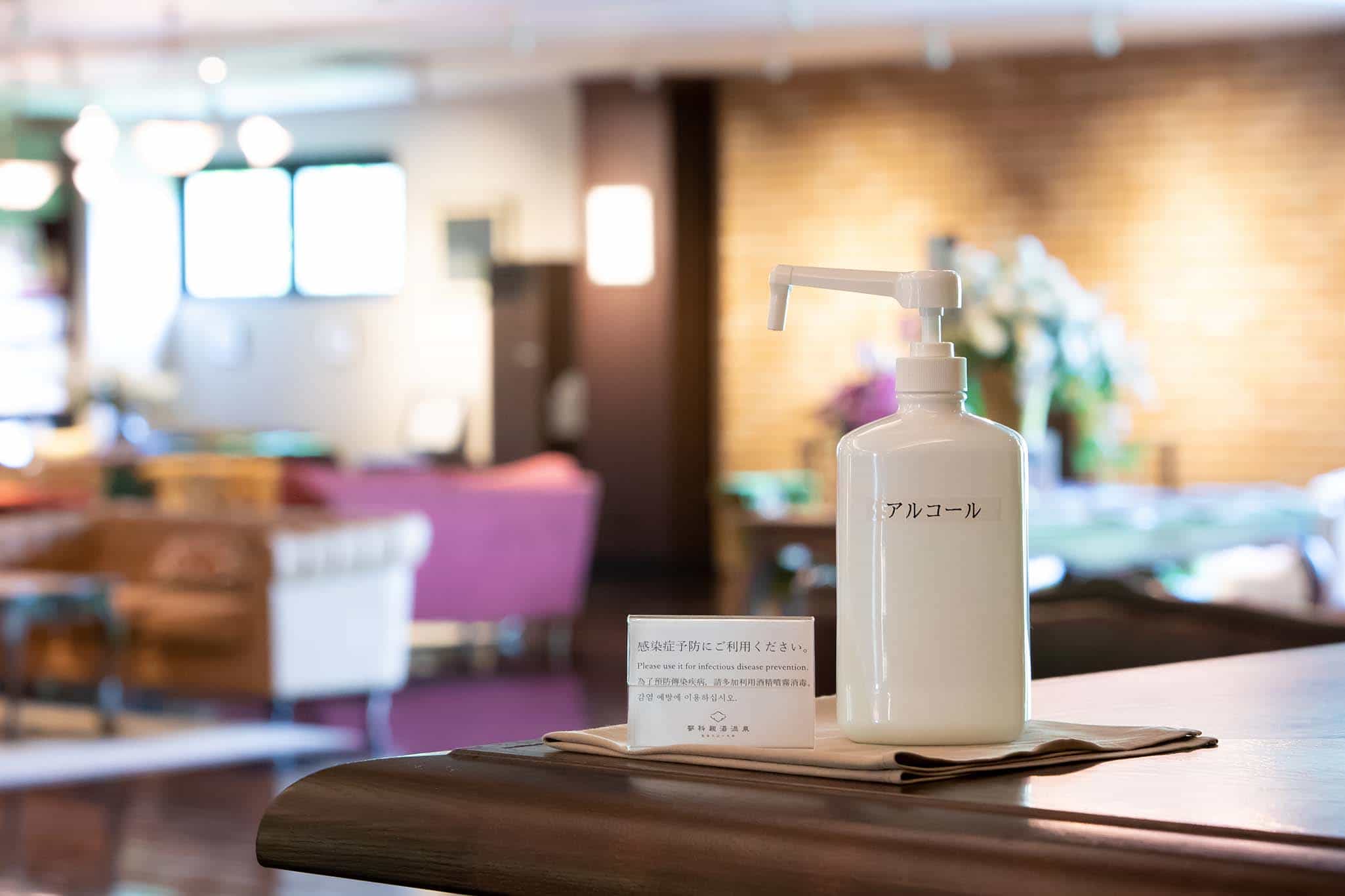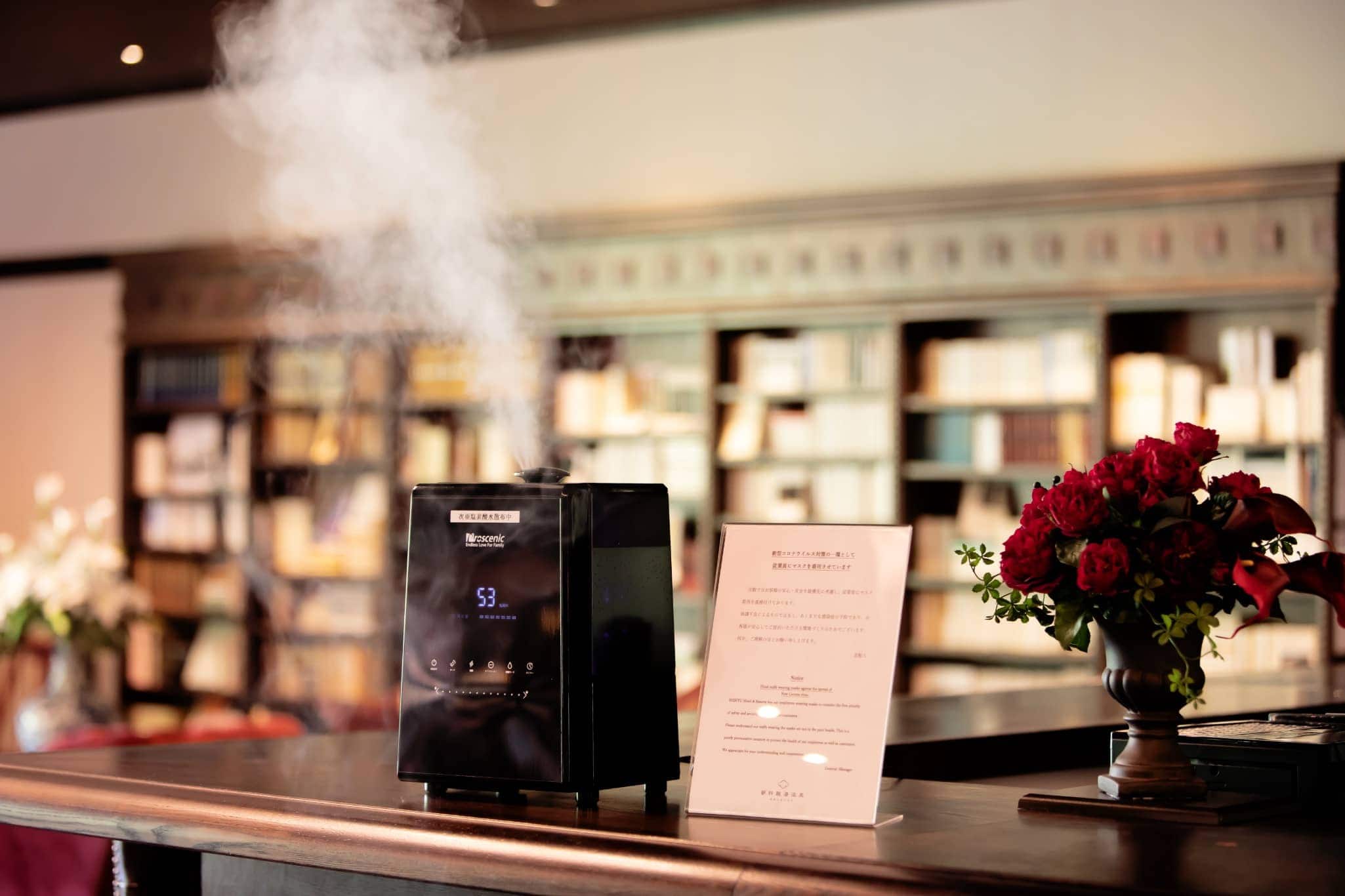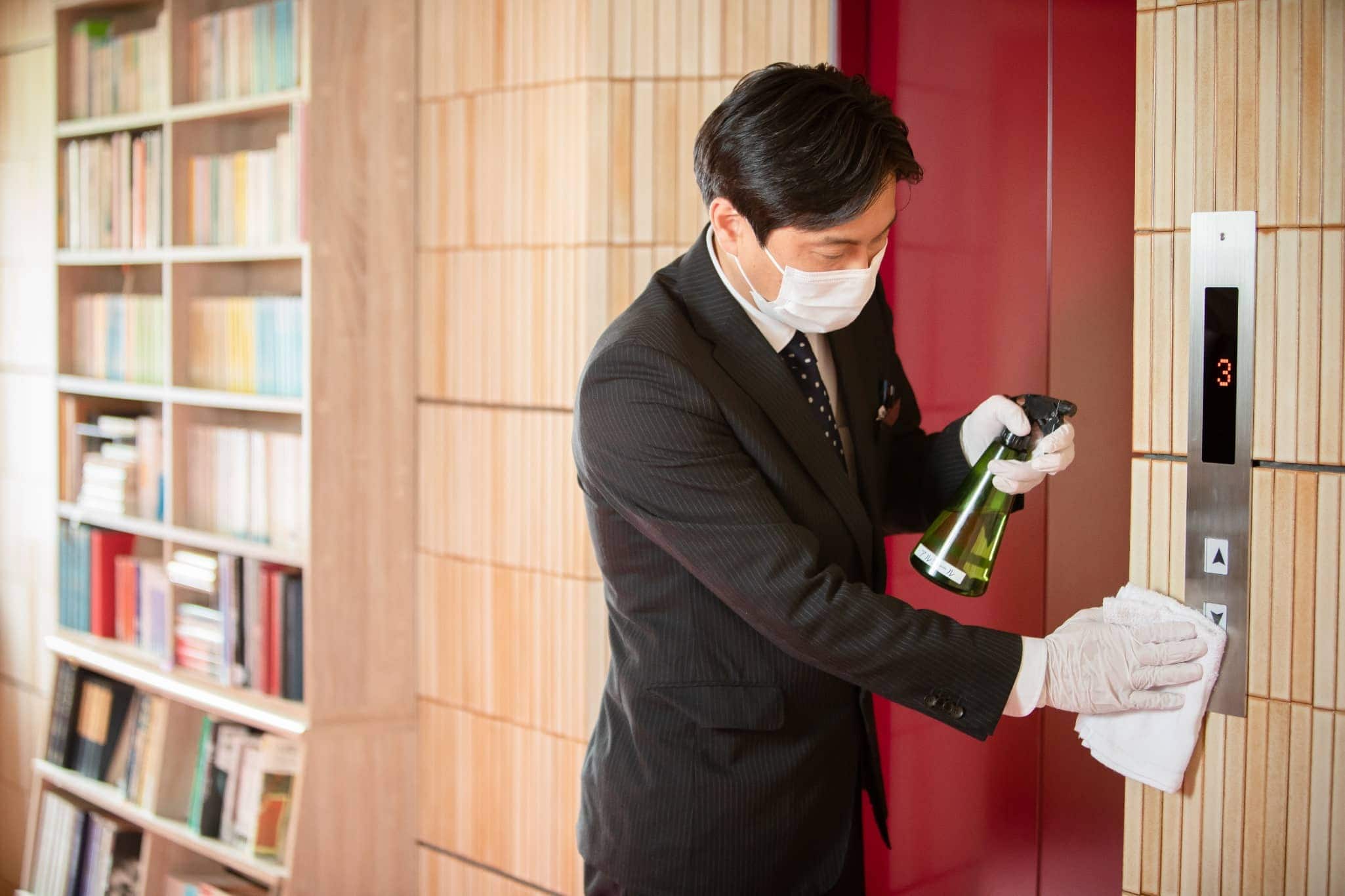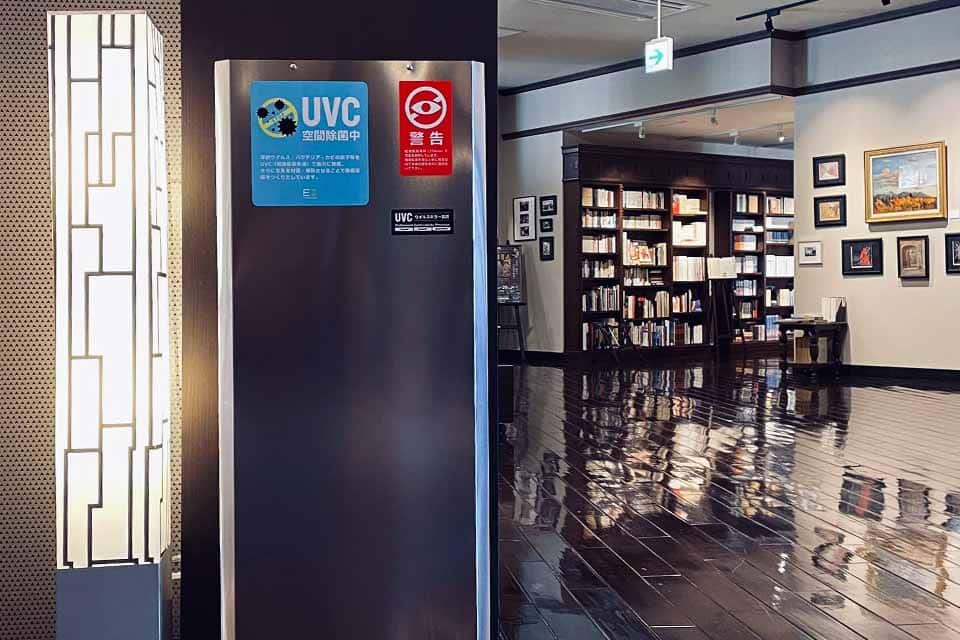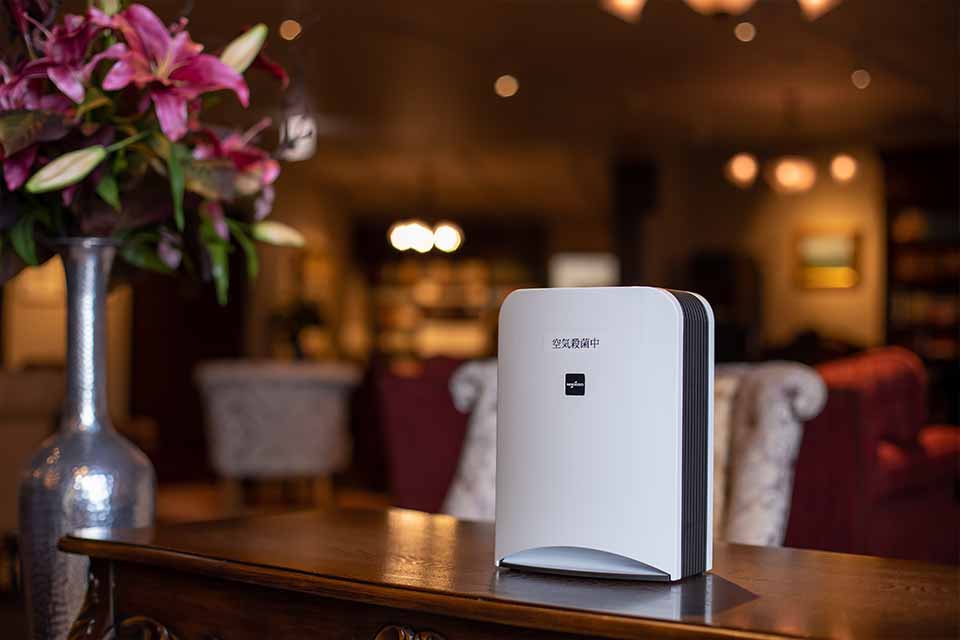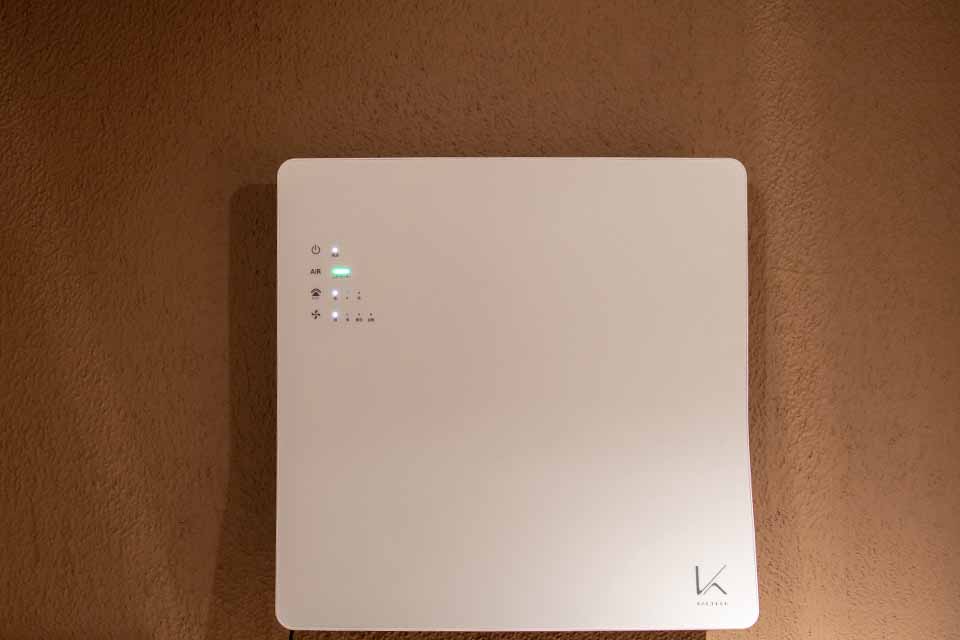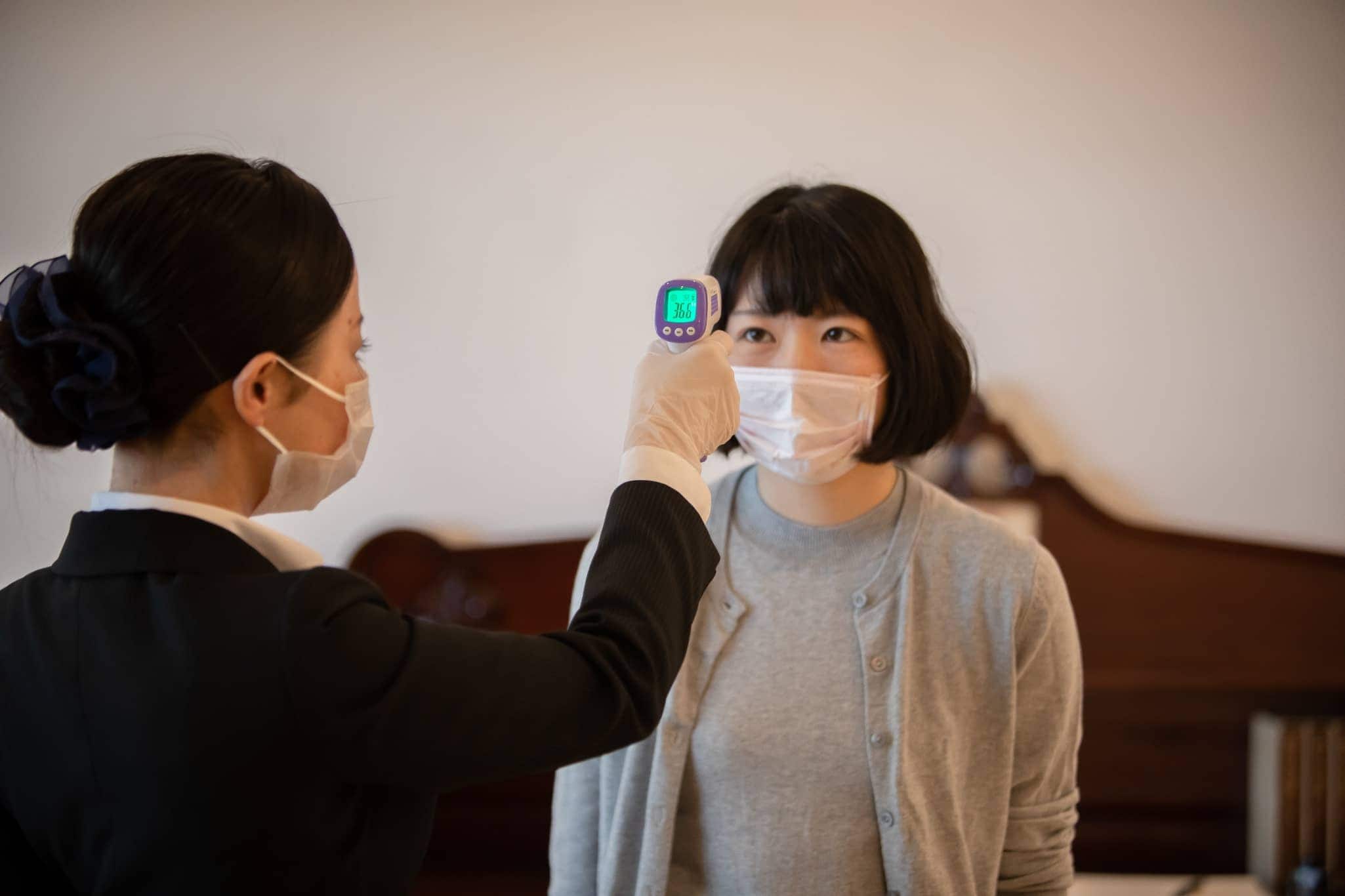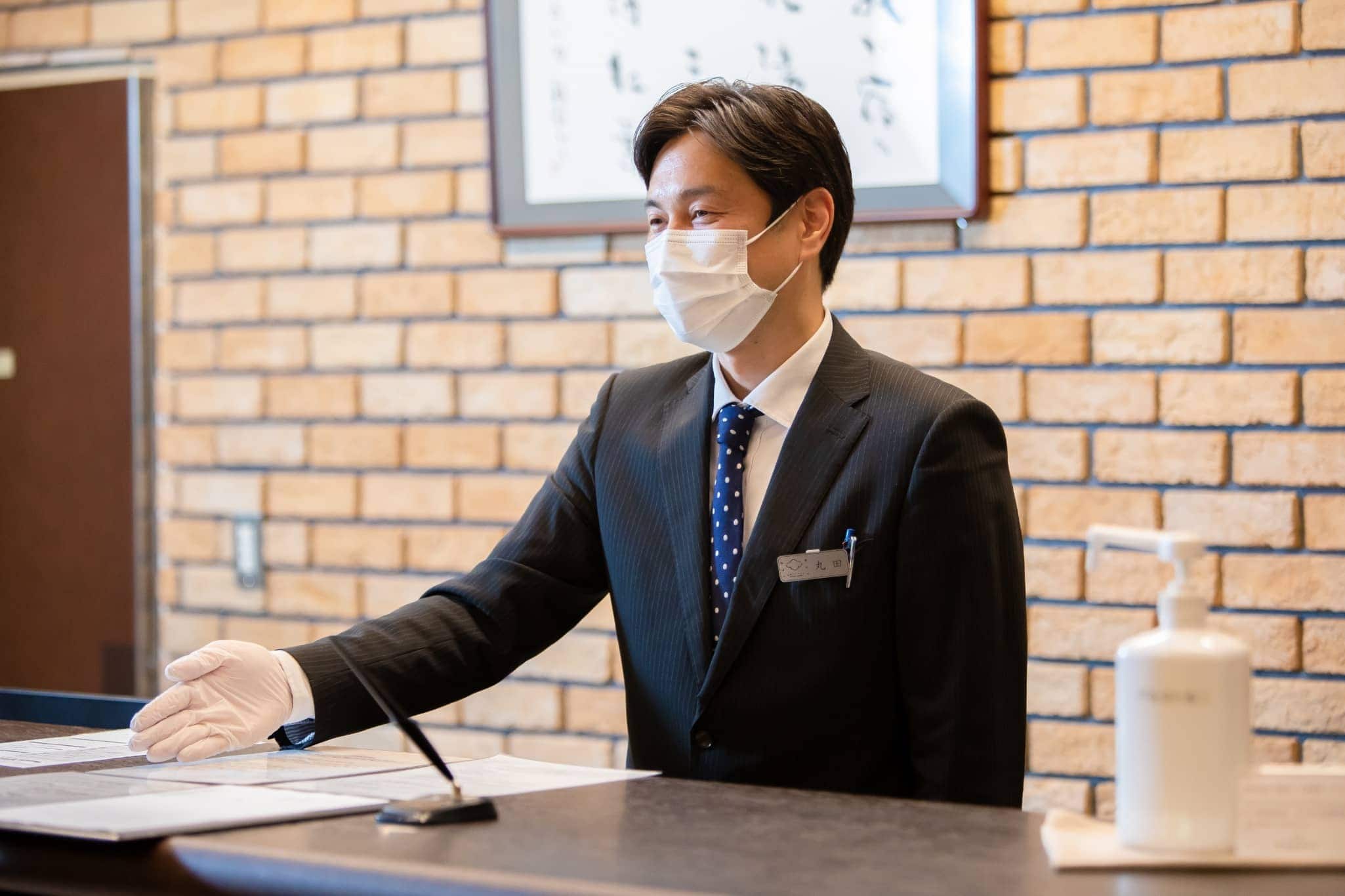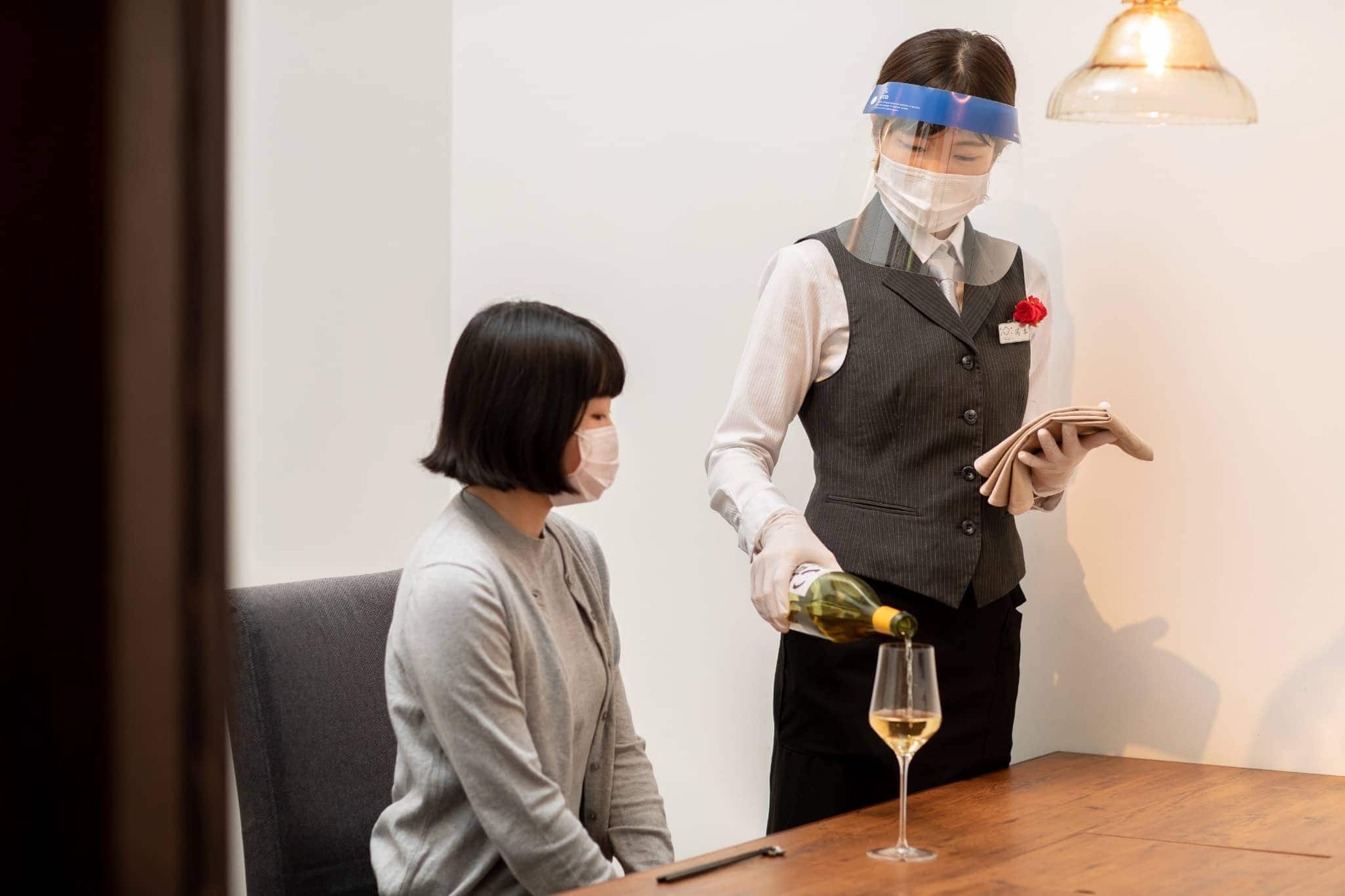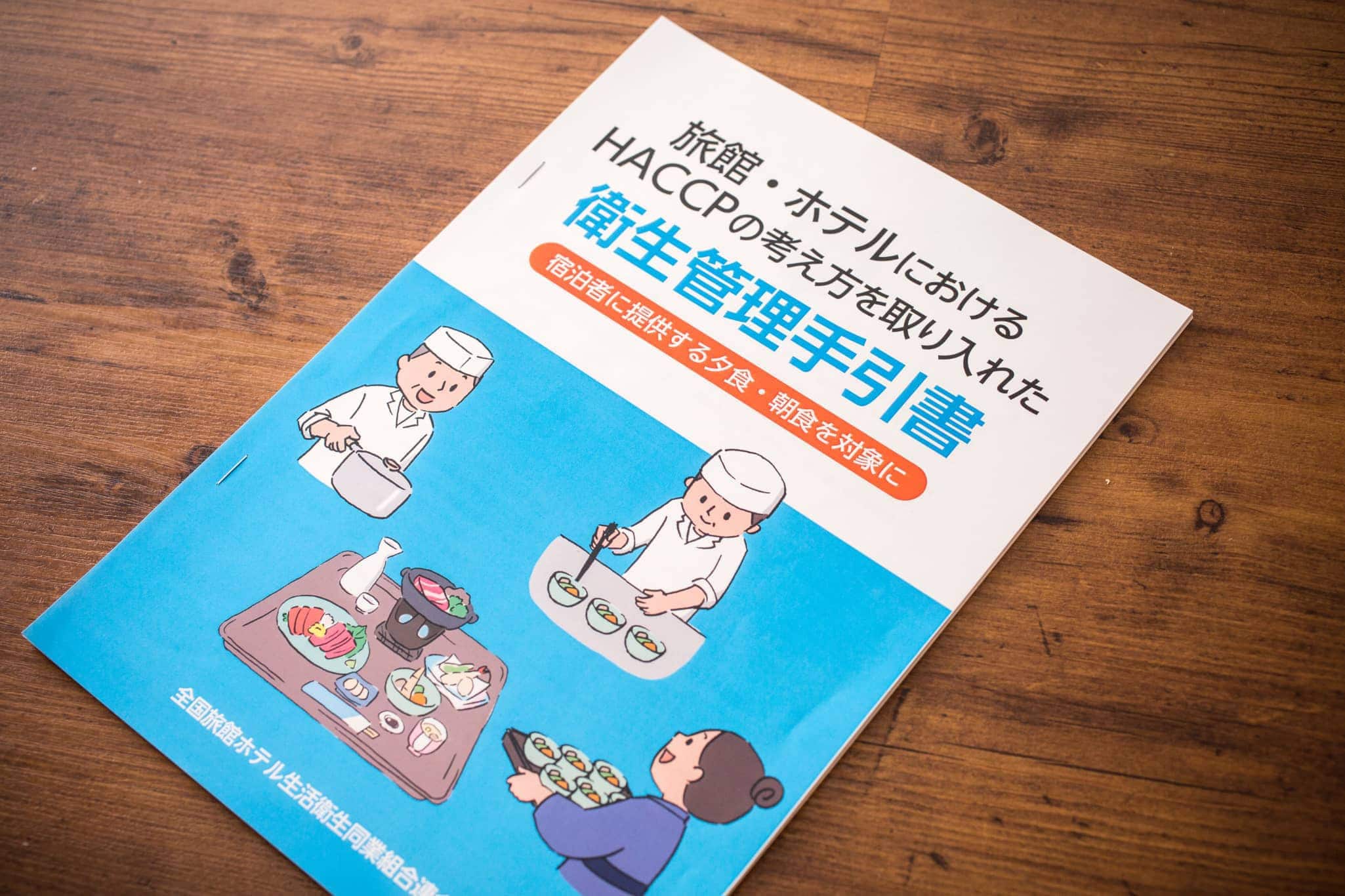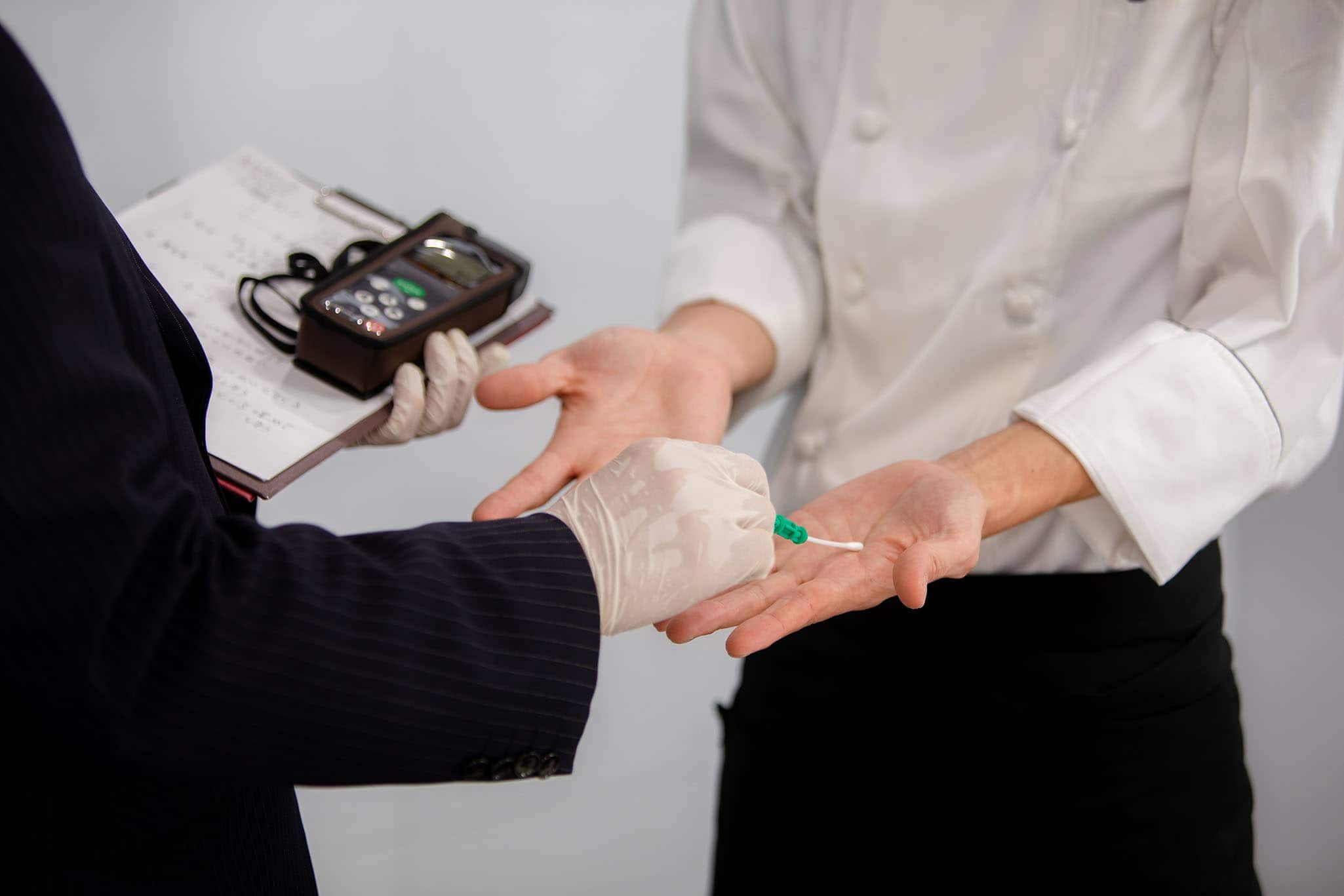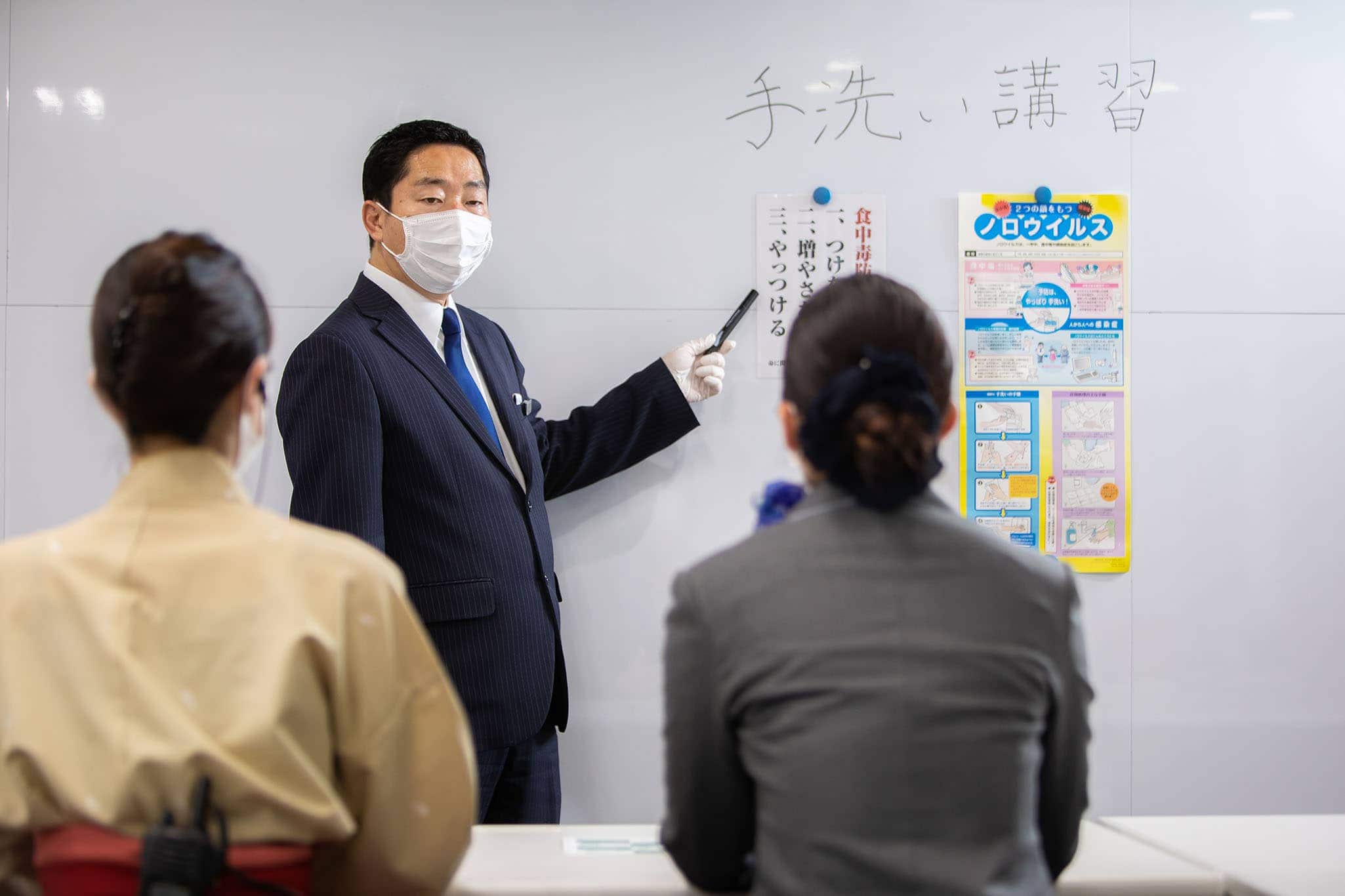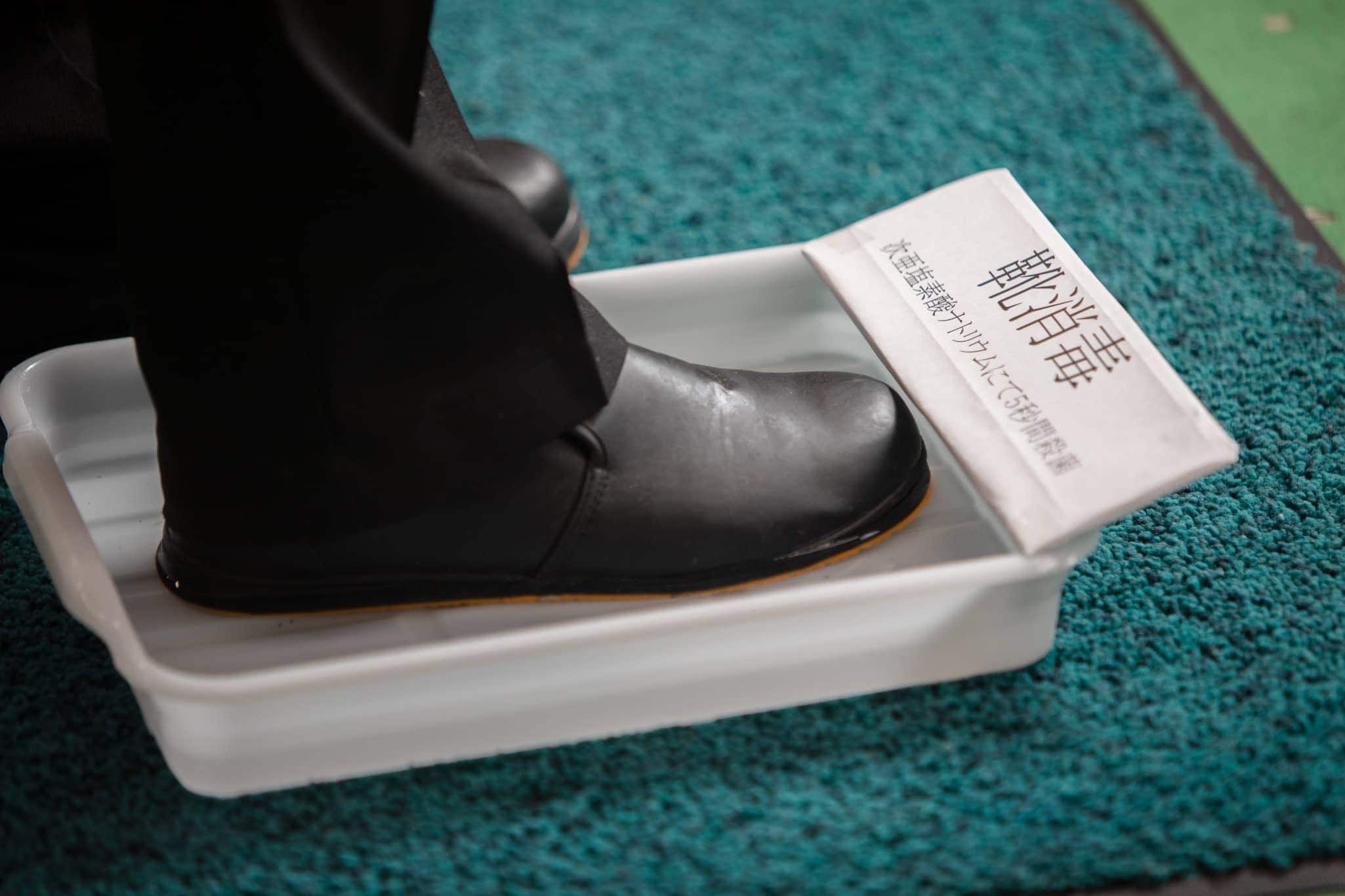Hygiene and Disinfection Program
Overview
Tateshina Shinyu Onsen introduced a new sanitation and disinfection program on June 1, 2020. The program consists of more than 30 items for creating a safe environment for our guests and employees.
The program consists of three aspects: (1) Facility hygiene management, (2) Prevention of person-to-person infections, and (3) Hygiene management training. In addition to the hygiene management activities already being conducted, we developed a new code of conduct stipulating avoidance of the three Cs (closed spaces, crowded spaces, and close-contact settings). The new code of conduct covers a wide range of issues devised to prevent and eliminate bacteria and viruses. We spend more time and effort on hygiene management and disinfection than ever before in order to create a safe environment for our customers and employees.
*This program was formulated based on the Guidelines for Responding to "COVID-19 in Accommodation Facilities (1st Edition)" by the All Japan Ryokan Hotel Association and "the Guidebook on Hygiene Management based on HACCP by the Ministry of Health", Labour and Welfare.
*The Hotel thoroughly enforces and implements the conditions of participation in GoTo Travel.
*Contents are subject to change depending on future circumstances.
Hygiene management in bathing areas
In order to ensure that our hot springs are safe to use, we manage hygiene in our public baths in full compliance with the methods and cleaning frequency stipulated by the Ministry of Health, Labor and Welfare and the Public Health Center.
Facilities
- Recirculating bathtub (The water is completely changed at least once a week, and the bathtubs are disinfected and cleaned.)
- Filters
- Chlorination equipment
Frequency
- Bathroom cleaning: Every day
- Drain cleaning: Once a week
- Chlorine disinfection: Every time the drains are cleaned (Chlorinators are in constant operation for disinfection and to maintain the chlorine concentration.)
- Residual chlorine concentration measurements: Every day (Adjusted from 0.4mg/L to 1.0mg/L or less for 2 hours or more a day)
Avoidance of the three Cs
(closed spaces, crowded spaces, and close-contact settings) and disinfection
A two-minute video explaining our hygiene and disinfection efforts
Contents
- Overview
- Avoidance of the three Cs (closed spaces, crowded spaces, and close-contact settings) and disinfection – A two-minute video explaining our hygiene and disinfection efforts
- Program consisting of facility hygiene management, prevention of person-to-person infections, and hygiene management training
- (1) Facility hygiene management
- The First Hotel in Eastern Japan to Implement the “Valpas” Bed Bug Prevention System
- Measurements of CO2 concentration and quantification of the three Cs
- Room sterilization and disinfection
- Automatic faucets in all public spaces in the Hotel
- Antibacterial and antiviral photocatalytic coatings
- Efforts in guest rooms: 5-step disinfection and cleaning of guest rooms using alcohol and hypochlorite water
- Efforts in public spaces: Cleaning, disinfection, and high-frequency ventilation cycle
- Efforts in public baths
- Efforts in food preparation areas
- Efforts in private dining rooms
- Efforts in shuttle buses
- (2) Prevention of person-to-person infections
- (3) Hygiene management training
- (1) Facility hygiene management
- Norovirus Countermeasures
- Emergency response and the Public Health Center
- What’s New in hygiene management
Program consisting of facility hygiene management, prevention of person-to-person infections, and hygiene management training
(1) Facility hygiene management
- Plasmacluster air purifiers installed in all guest rooms
The world’s first plasmacluster technology to be proven effective in reducing airborne COVID-19 transmission - Alcohol disinfection pumps installed (in all public spaces)
- Acrylic board partitions installed to prevent droplet infections (at counters in all public spaces)
- Ozone sterilization late at night and at check-out time (in all public spaces and food preparation areas)
- Humidifiers filled with hypochlorite water in operation late at night (in all public spaces)
National Institute of Technology and Evaluation (NITE) release: Hypochlorite water disinfection confirmed effective against COVID-19 - Disinfection using sprayers (at the end of cleaning in all guest rooms and public spaces)
- Disinfection of areas with a high risk of contact infections
- UV ray disinfection of remote-control devices, etc.
- Installation of antibacterial mats at entrances
- Hygiene inspections by an external organization
- All rooms non-smoking, with smoking areas provided in accordance with the law
The First Hotel in Eastern Japan to Implement the “Valpas” Bed Bug Prevention System
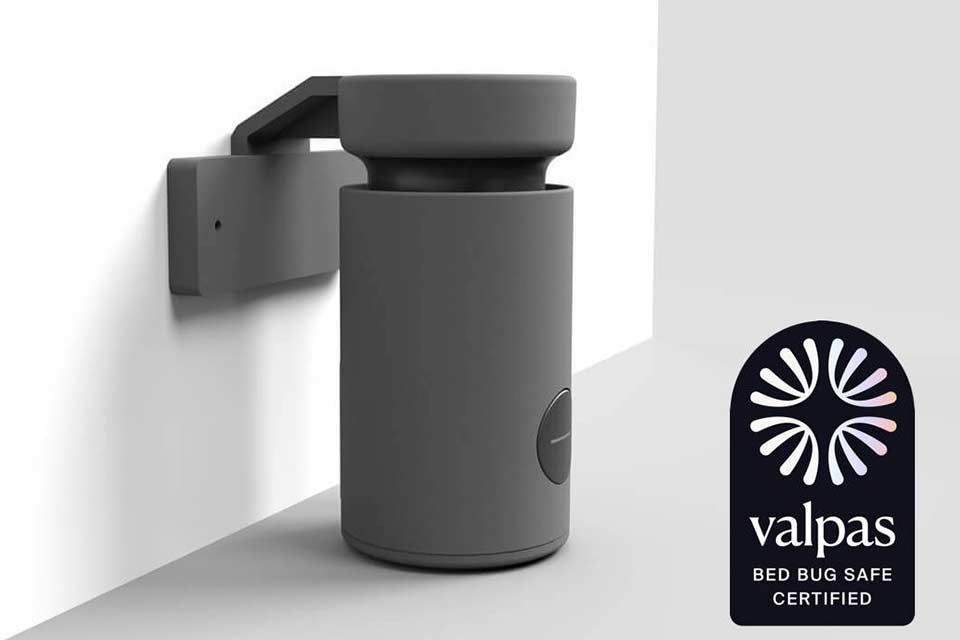
As of October 2025, Tateshina Shinyu Onsen has installed the patented Valpas bed bug prevention device in all guest rooms—making us the first hotel in Eastern Japan to introduce this system.
Bed bugs are parasitic insects that feed on human blood and can cause intense itching. They may be carried into a room via luggage or clothing, meaning that even the cleanest environments cannot guarantee complete protection. To ensure absolute peace of mind during your stay, we have adopted Valpas, a system specifically designed to prevent bed bugs before they become a concern.
Valpas is a patented smart device now used in many luxury hotels around the world.
Its specialized design and materials recreate the conditions that bed bugs seek, effectively attracting and trapping them. The system also connects to a dedicated application that continuously monitors safety in real time. When a capture is detected, staff members are immediately notified, allowing prompt action before any risk of spreading. With no chemicals involved, Valpas offers a safe and environmentally friendly approach to bed bug prevention.
*Please note that this system has been introduced purely as a preventive measure. No bed bugs have ever been detected at our hotel.
Measurements of CO2 concentration and quantification of the three Cs
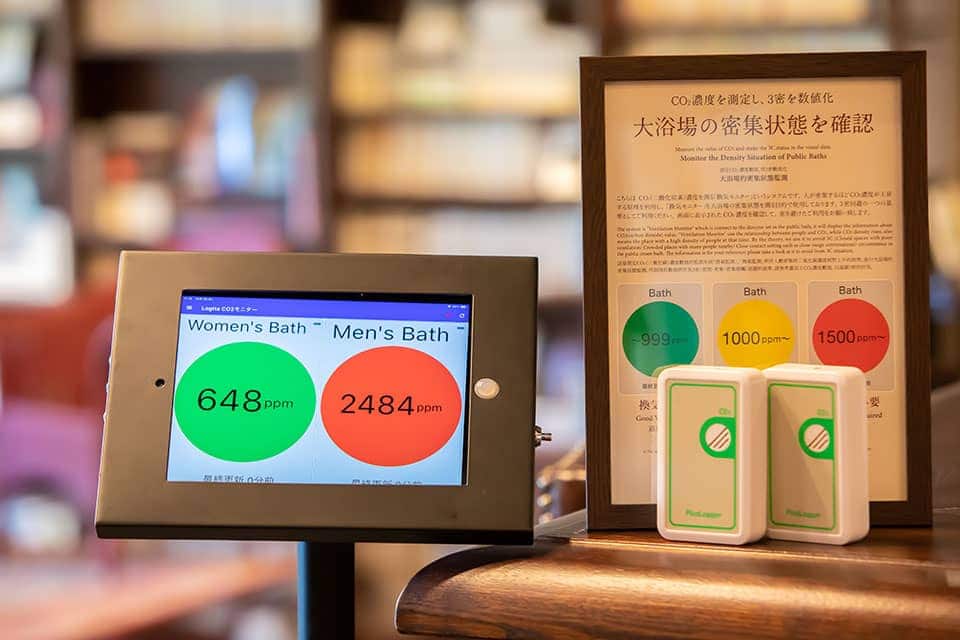
In order to visualize the status of the three Cs in the hotel, we installed a system called a CO2 sensor. The CO2 Sensor measures carbon dioxide (CO2) concentrations. It is used to measure the degree of crowdedness in public spaces, such as public baths, based on the principle that the CO2 density increases the more crowded a place is. The CO2 concentration is displayed on the monitor screen in three levels (green, yellow, and red) accompanied by a warning sound. Please use this as a guide for avoiding the three Cs. Please monitor the CO2 concentration displayed on the screen to avoid closed and crowded areas.
[Three-level display]
- Green Less than 999 ppm indicates good ventilation (not crowded)
- Yellow Between 1,000 and 1,499 ppm indicates that ventilation is recommended (slightly crowded)
- Red 1,500 ppm and over indicates that ventilation is necessary (crowded)
*The values recommending ventilation due to a high concentration of CO2 are based on the values announced by the Ministry of Health, Labour and Welfare.
https://www.mhlw.go.jp/content/10900000/000618969.pdf
Room sterilization and disinfection
In light of the fact that COVID-19 infections can spread via the air, we have installed room sterilizers and disinfectors in public spaces throughout the hotel. We are striving to provide a safe environment by utilizing the latest technologies, such as deep ultraviolet LEDs with high sterilization efficacy and photocatalysts that break down and eliminate viruses.
Automatic faucets in all public spaces in the hotel
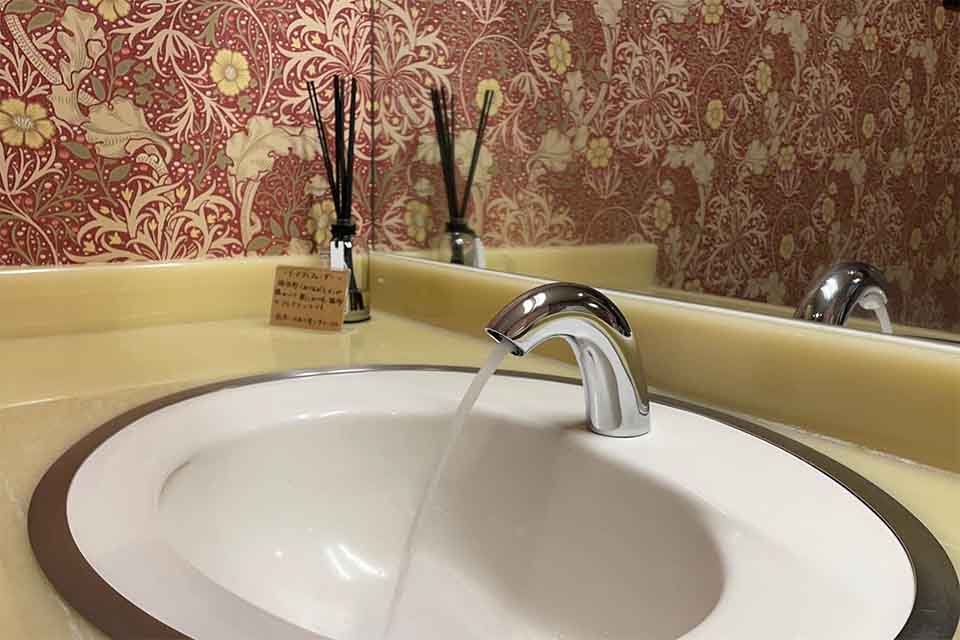
The hotel works to minimize the risk of infection by increasing the number of procedures that can be performed non-contact. As part of this effort, we have replaced the faucets in all public spaces with automatic faucets. We have also applied antibacterial and antiviral photocatalytic coatings to surfaces that require contact (buttons and handrails).
Antibacterial and antiviral photocatalytic coating
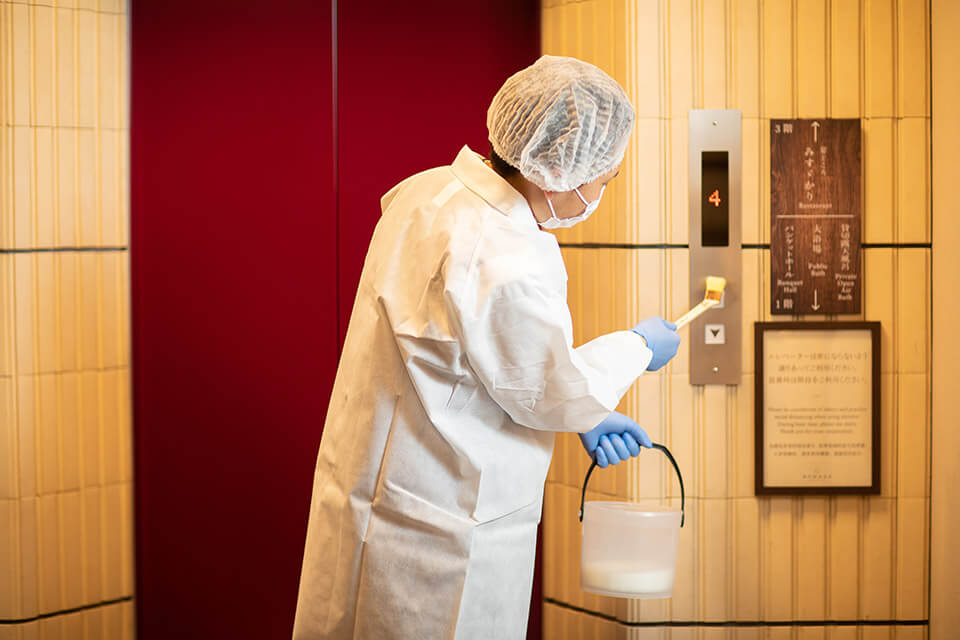
We have applied an antibacterial and antiviral photocatalytic coating to surfaces that people touch (door knobs in all guest rooms, all handrails and elevator buttons in the hotel, etc.). Surfaces with a photocatalytic coating are clearly indicated with stickers.
Efforts in guest rooms: 5-step disinfection and cleaning of guest rooms using alcohol and hypochlorite water
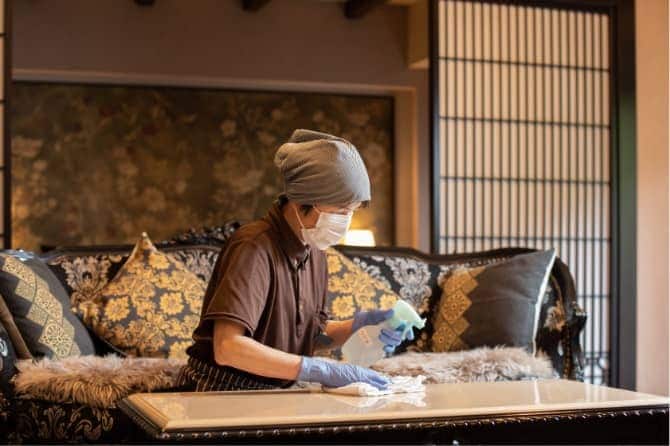
(1) Cleaning
Cleaning staff members wear masks and gloves while cleaning guest rooms.
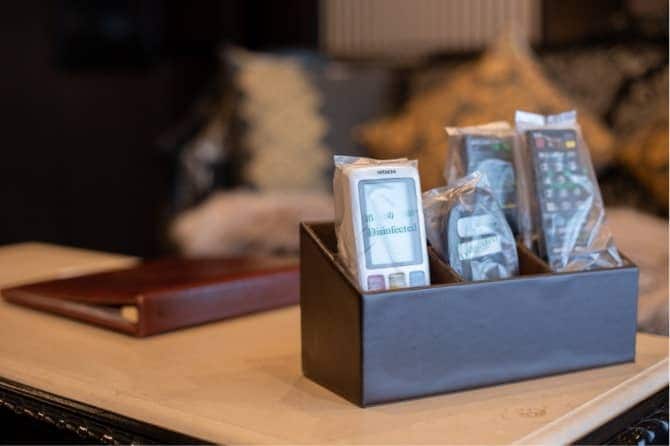
(2) Alcohol disinfection and UV disinfection
We disinfect surfaces that people touch (tables, sofas, remote controls, handsets, switches, handles, doorknobs, etc.) using alcohol. Remote-control devices, etc. are disinfected using ultraviolet light and packed in disinfection bags.
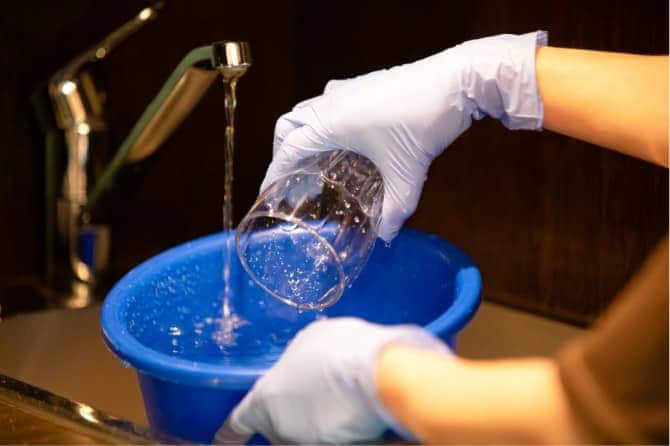
(3) High-temperature washing and hypochlorite water disinfection of glasses, etc. provided in guest rooms
Glasses, etc. provided in guest rooms are washed at high temperature and disinfected with hypochlorite water. After disinfection, they are packed in disinfection bags.
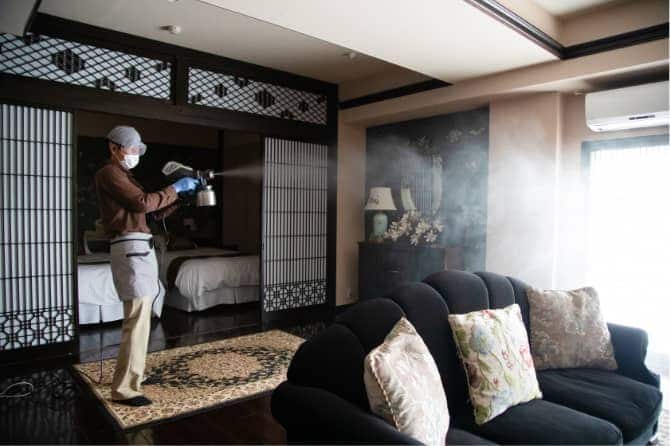
(4) Hypochlorite water disinfection using sprayers
We spray hypochlorite water, which is effective in inactivating viruses and removing allergens, in all guest rooms.
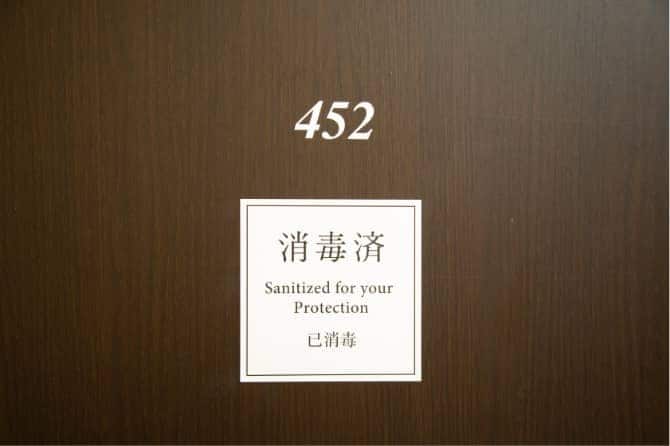
(5) Disinfected stickers
Once guest rooms have been disinfected, a disinfected sticker is placed on the door of the room as an indicator to ensure that all rooms get disinfected. Only the guests who are scheduled to occupy the disinfected room on that day are allowed to enter.
Efforts in public spaces: Cleaning, disinfection, and high-frequency ventilation cycle
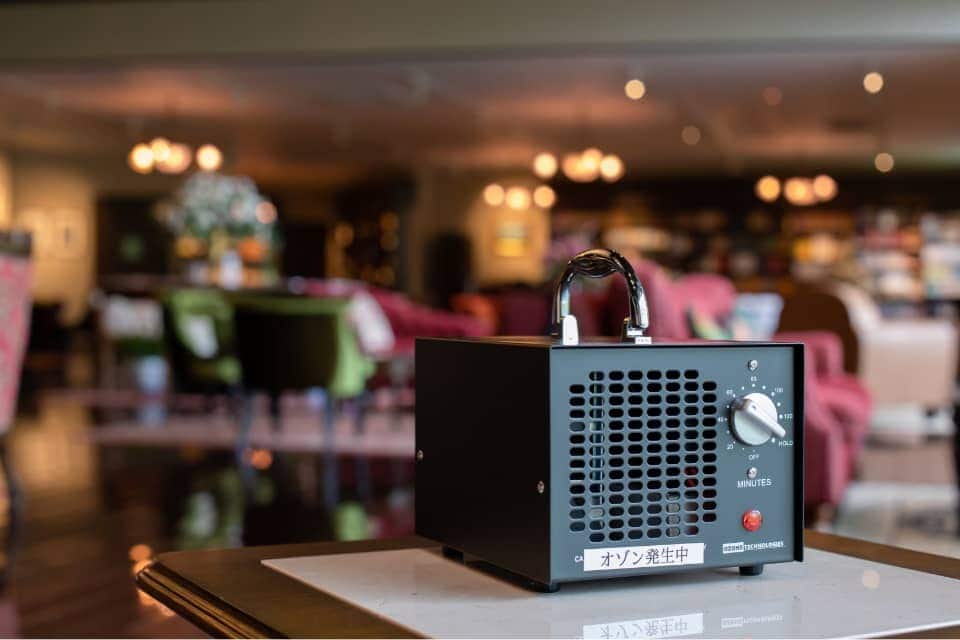
(1) Regular cleaning of public spaces
We have increased the frequency that public spaces are cleaned since June.
(2) Installation of humidifiers filled with hypochlorite water to operate late at night
We have installed humidifiers filled with hypochlorite water, which is effective in inactivating viruses and removing allergens, in public spaces such as changing rooms, the front counter, the lobby, and food preparation areas for operation late at night.
(3) Ozone sterilization late at night
We use ozone sterilizers to remove bacteria and viruses from public spaces late at night when no guests are present.
(4) Regular ventilation
We regularly ventilate public spaces to reduce stagnation and the proliferation of viruses and bacteria.
Efforts in public baths
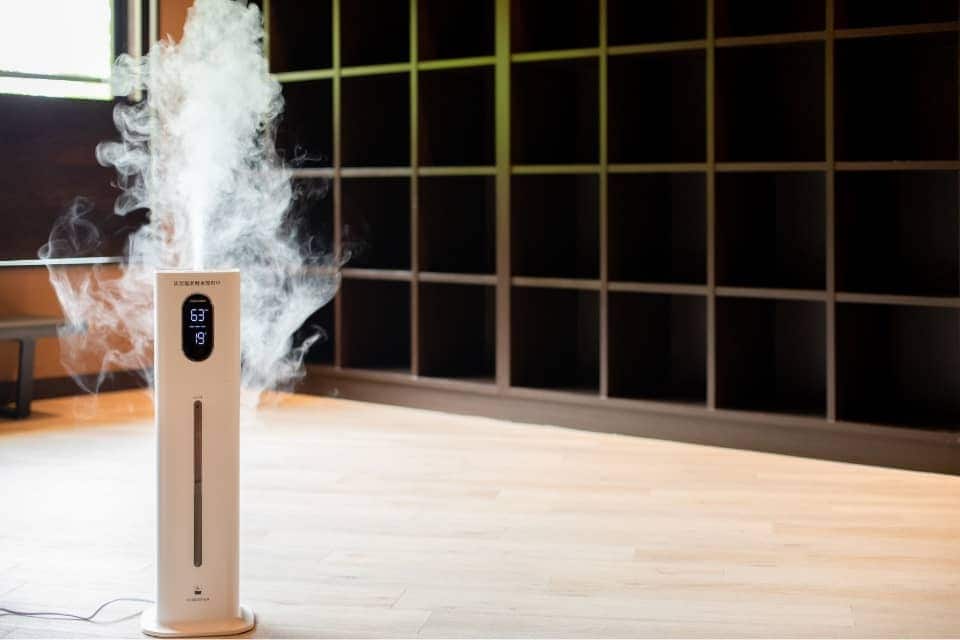
In order to avoid crowding in the public baths, we have suspended day spa services for the time being. While suspended, only guests staying at the hotel are able to use the hot spring baths. Alcohol disinfection pumps have been installed in the changing rooms. Late at night, we operate humidifiers filled with hypochlorite water and ozone sterilizers. All equipment (baskets, hair dryers, etc.) in the changing rooms is also frequently disinfected. The hot spring water is disinfected using chlorine. We also control meal times to avoid the three Cs in the public baths. Please note that use of the bathing areas may be restricted without notice. We appreciate your understanding.
Efforts in food preparation areas
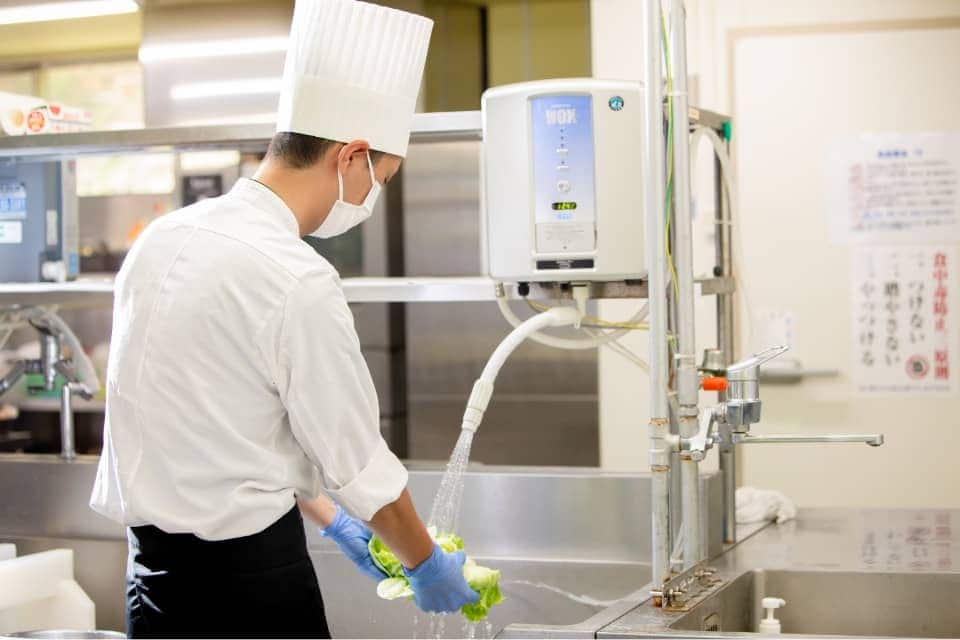
We have introduced Hazard Analysis and Critical Control Point (HACCP) standards for food hygiene in food preparation areas, and pay special attention to hygiene management. We also carefully sanitize delivered food ingredients and other deliverables, and disinfect shoes and clothing when entering food preparation areas.
※HACCP stands for Hazard Analysis Critical Control Point. HACCP is a food hygiene management method requiring important matters relating to the condition and handling of food items to be recorded and controlled. It was announced by the Codex Committee on Food Hygiene, a joint organization of the Food and Agriculture Organization of the United Nations (FAO) and the World Health Organization (WHO). The hotel complies with HACCP in food hygiene management.
Efforts in private dining rooms
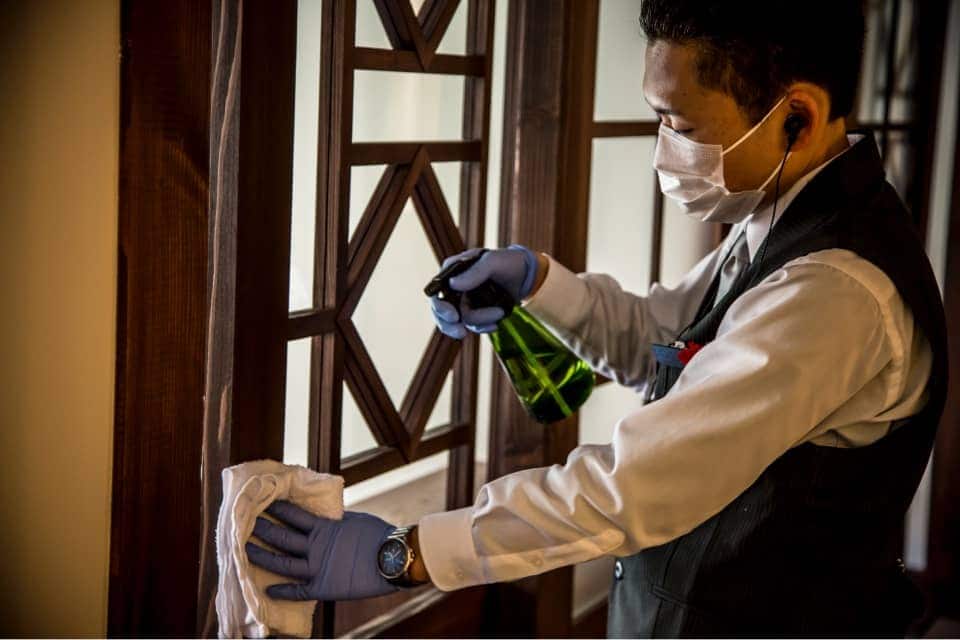
Course meals at the hotel are served in private rooms. After use, we disinfect with hypochlorite water using sprayers and also disinfect tables and other small fixtures such as handles with alcohol.
Efforts in shuttle buses
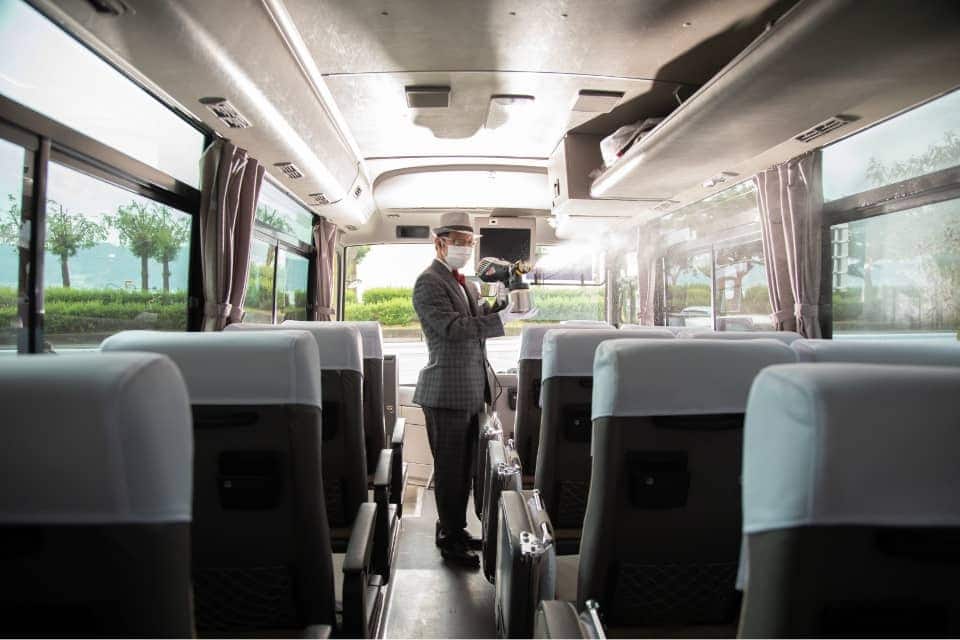
We use humidifiers and sprayers filled with hypochlorite water to disinfect the interiors of our shuttle buses. Alcohol disinfection pumps are installed in the buses. Bus service takes social distancing into consideration by limiting the number of passengers and ensuring spaced seating.
(2) Prevention of person-to-person infections
- Temperature and physical condition records for all employees
- Requirement to gargle, wash hands, and disinfect with alcohol when arriving at work and during one’s duties
- Monthly stool analyses and norovirus testing (November to March)
- Administration of influenza shots
- Mask wearing by all employees at all times
- Gloves used when cleaning
- Gloves used when preparing and serving food
- Face shields worn when serving food to guests who request it
- Course meals served in private rooms
- Guests may choose where to have their lunch served
- Requesting all guests to check their temperature and disinfect using alcohol upon entry into the hotel
- Requesting all guests to confirm their identification and physical condition upon check-in.
*If a guest displays symptoms of a fever or a cold, entry will be restricted, and appropriate measures will be taken after seeking instructions from the Public Health Center, etc.
- Requesting that all guests wear a mask when in public spaces
- Requesting all guests to refrain from talking in bathrooms and elevators
- Requesting all guests to disinfect using alcohol and wear a mask when riding the shuttle bus
- Social distance monitoring
- Limiting occupancy to 50% of capacity
- Requesting all suppliers to wear masks and gloves
- Loaning out pulse oximeters (oxygen analyzers) *1
- *1 The hotel will make no judgments on the measured values.
Antigen testing
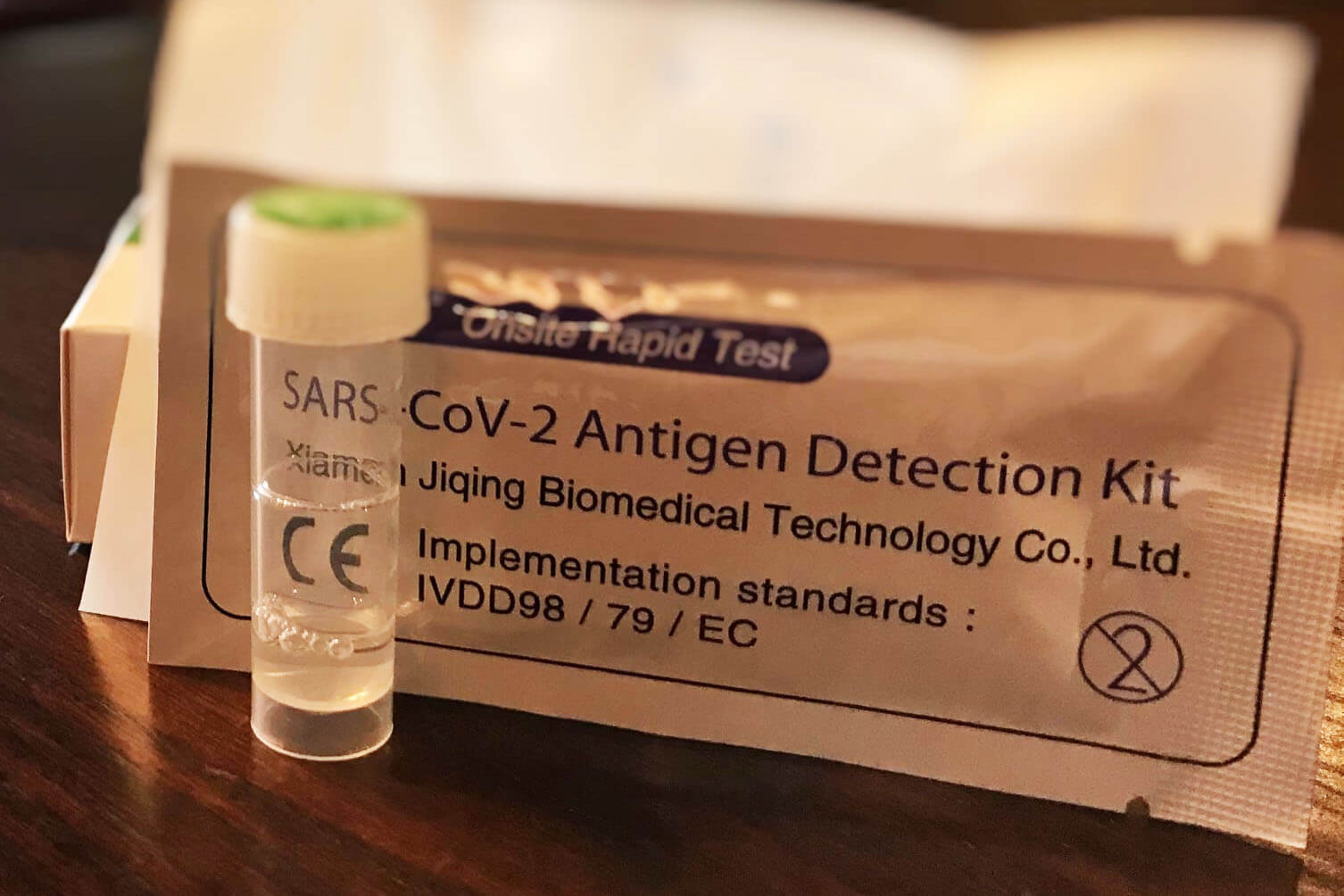
We have been conducting COVID-19 antigen testing for all employees monthly since August 2021. For the safety and security of our guests and employees, we plan to continue conducting monthly testing for as long as there are concerns about COVID-19 infections.
(3) Hygiene management training
- Education and raising awareness of our Hygiene and Disinfection Program 2020
This program was formulated based on the Guidelines for Responding to COVID-19 in Accommodation Facilities (1st Edition) by the All Japan Ryokan Hotel Association and the Guidebook on Hygiene Management based on HACCP by the Ministry of Health, Labour and Welfare. We provide all employees with training on the purpose and necessity of formulating this program.
- ATP testing (to measure the number of bacteria on fingers and visualize the state of hand-washing)
- Hand-washing training
- Hygiene management training by external instructors
- Hygiene management manuals for food preparation areas and providers
- Hygiene manuals for food preparation area operations divided into eight processes
Overview of the operations hygiene manual
- Before work
- Hand washing and disinfection
- Disinfection of work shoes
- Disinfection of utensils, work tables, refrigerators, etc.
- Inspection and storage of food items
- Inspection, recording in a ledger, and storage (storage to prevent cross-contamination)
- Quality, freshness, packaging, temperature
- Pre-processing
- Care not to conduct simultaneously with non-contaminating work
- Hand washing and disinfection after pre-processing
- Storage and management of raw ingredients, etc.
- Vegetables and fruits: Washing under running water, sterilization with sodium hypochlorite solution if necessary, and rinsing under running water after sterilization
- Seafood and meat: If necessary, soaking in hypochlorite water then rinsing under running water
- Food preparation
- Cleaning and disinfection of worktops and water tanks
- Ensuing that the center of the food is heated to sterilization temperature when cooking
- Hand washing and disinfection before working
- Checking the temperature and humidity in the food preparation area, recording in a ledger, storing, and ensuring adequate ventilation
- Serving
- Avoidance of direct contact with food
- Maintaining food items at the proper temperature once cooked
- Facility and equipment sanitation
- Using each area for a single purpose only/li>
- Recording temperature in the facility and storing
- Management of workers
- Individually recording and storing the health condition of each worker using a hygiene management inspection sheet
- Ensuring physical cleanliness at all times, and wearing cooking clothes, aprons, masks, hats, and footwear
- Conducting stool analyses → Not allowing the worker to perform duties if the aforementioned results indicate a problem with food hygiene
- Before work
- Evaluations of employees’ understanding and implementation of hygiene management
Norovirus Countermeasures
At our inn, we value not only providing a place to stay, but also a “safe space to stay” for our guests. Infectious diseases caused by norovirus have become a nationwide problem in recent years. Norovirus is especially prevalent in the wintertime and is highly contagious, but the hotel is committed to thorough hygiene management, including daily hand washing, as well as training and periodic inspections to prevent norovirus. We hope that these efforts will lead to smiles and trust from our guests.
Encouragement of hand washing by all staff
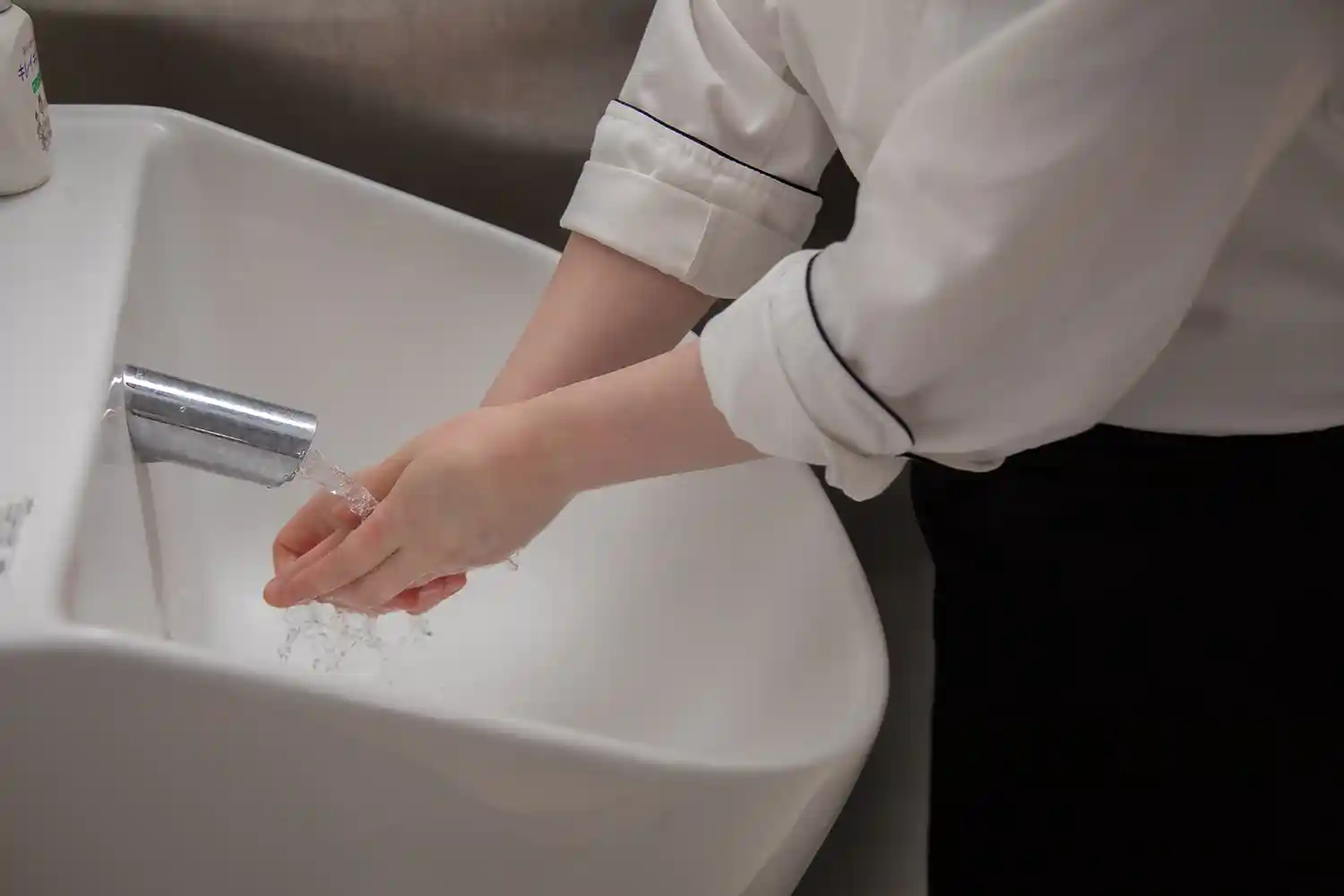
“Handwashing” is the basis of hygiene and disinfection. To ensure that our customers can spend their time with peace of mind, all staff, including new hires, are committed to hygiene management, including hand washing, with an awareness of norovirus countermeasures.
Vomit Disposal Training
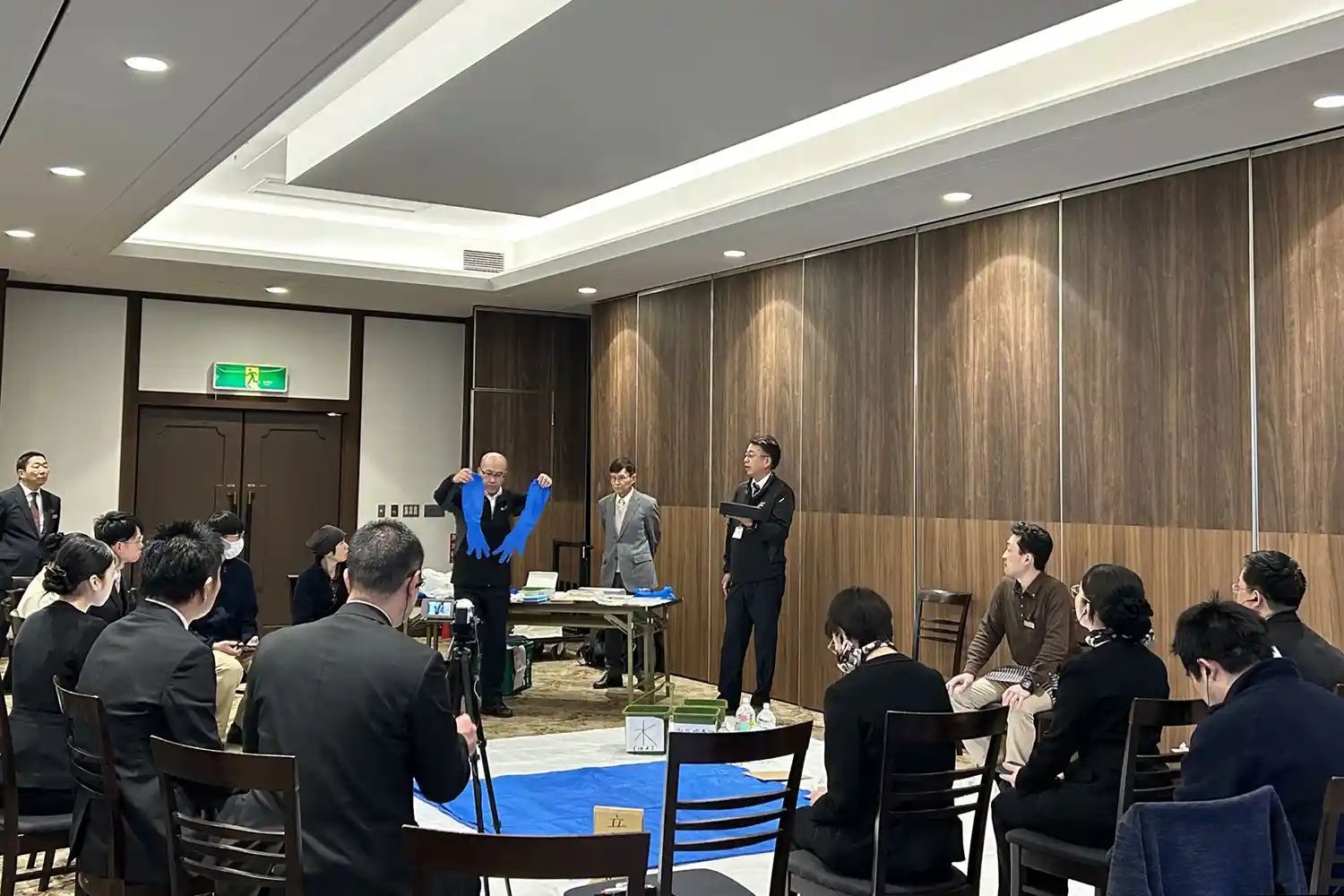
Every year, we conduct training on vomit disposal to prevent the spread of infectious diseases. The training is conducted by a professional instructor and attended by approximately 20 staff members, including those from sister facilities. Through a combination of classroom and practical training, participants learn how to dispose of vomit and clean up in order to prevent norovirus and other infectious diseases, and acquire proper disposal procedures. All participants take the program seriously in order to be able to respond quickly and accurately in the event of an emergency.
Periodic [Norovirus Testing]
We conduct monthly norovirus inspections during the season when norovirus is prevalent. Every year, all staff involved in food and beverage operations are inspected on an ongoing basis. By conducting this periodic inspection, we strive to ensure thorough food hygiene management and provide a safer dining environment for our customers.
Hospital and Health Center
for Emergencies
An emergency hospital is located near the hotel.
Suwa Central Hospital / 15 min by car
TEL: +81-266-72-1000
Address: 4300 Tamagawa, Chino City, Nagano Prefecture 391-8503
The hotel is within the service area of the Suwa Health Center.
Suwa Health Center TEL: +81-266-53-6000

